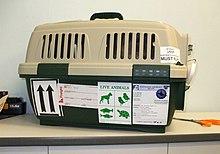
An animal shelter or pound is a place where stray, lost, abandoned or surrendered animals – mostly dogs and cats – are housed. The word "pound" has its origins in the animal pounds of agricultural communities, where stray livestock would be penned or impounded until they were claimed by their owners.
The Pet Travel Scheme ("PETS") is a system which allows animals to travel easily between member countries without undergoing quarantine. A pet passport is a document that officially records information related to a specific animal, as part of that procedure. The effect is to drastically speed up and simplify travel with and transport of animals between member countries, compared to previous procedures if the regulations are followed.

Although capable of living indoors with humans similarly to cats or dogs, pet skunks are relatively rare, partly due to restrictive laws and the complexity of their care. Pet skunks are mainly kept in the United States, Canada, Germany, the Netherlands, Poland, and Italy.

A dog bite is a bite upon a person or other animal by a dog, including from a rabid dog. More than one successive bite is often called a dog attack, although dog attacks can include knock-downs and scratches. Though some dog bites do not result in injury, they can result in infection, disfigurement, temporary or permanent disability, or death. Another type of dog bite is the "soft bite" displayed by well-trained dogs, by puppies, and in non-aggressive play. Dog bites can occur during dog fighting, as a response to mistreatment, by trained dogs working as guard, police or military animals, or during a random encounter.
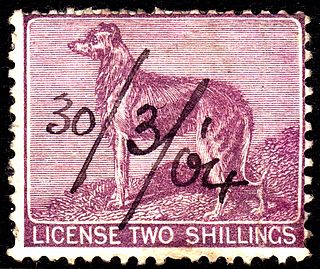
A dog licence is required in some jurisdictions to be the keeper of a dog. Usually a dog-licence identifying number is issued to the owner, along with a dog tag bearing the identifier and a contact number for the registering organization. If a stray pet is found with the tag, a rescuer can call the registering organization to get current contact information for the animal.

World Animal Protection, formerly The World Society for the Protection of Animals (WSPA) is an international non-profit animal rights organization that has been in operation since 1981. The charity describes its vision as: A world where animal rights matter and animal cruelty has ended.
Point-to-point transit is a transportation system in which a plane, bus, or train travels directly to a destination, rather than going through a central hub. This differs from the spoke-hub distribution paradigm in which the transportation goes to a central location where passengers change to another train, bus, or plane to reach their destination.

A travel document is an identity document issued by a government or international entity pursuant to international agreements to enable individuals to clear border control measures. Travel documents usually assure other governments that the bearer may return to the issuing country, and are often issued in booklet form to allow other governments to place visas as well as entry and exit stamps into them.

Vaccination of dogs is the practice of animal vaccination applied to dogs. Programs in this field have contributed both to the health of dogs and to the public health. In countries where routine rabies vaccination of dogs is practiced, for example, rabies in humans is reduced to a very rare event.
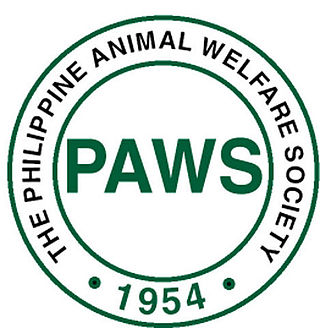
The Philippine Animal Welfare Society (PAWS) is a volunteer-based, non-government organization whose goal is to prevent animal cruelty through education, animal sheltering and advocacy, based in Quezon City, Philippines. It was founded in 1954 by Muriel Jay. PAWS believes that the creation of a more peaceful society starts with the widening of mankind's circle of compassion which includes animals, thereby envisions a nation that respects animals, practices responsible pet ownership and protects wildlife. The volunteer-based organization rehabilitates these animals in the hope of finding them new homes and a second chance at a good life. PAWS does not take in pets of other people, but only victims of cruelty or neglect where the animal offenders are charged with violation of the Animal Welfare Act in court.
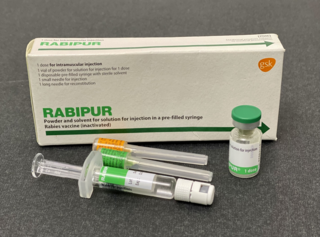
The rabies vaccine is a vaccine used to prevent rabies. There are a number of rabies vaccines available that are both safe and effective. They can be used to prevent rabies before, and, for a period of time, after exposure to the rabies virus, which is commonly caused by a dog bite or a bat bite.
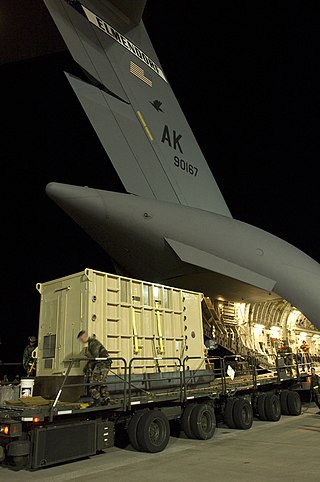
The transportation of animals is the intentional movement of non-human animals by transport. Common categories of animals which are transported include livestock destined for sale or slaughter; zoological specimens; laboratory animals; race horses; pets; and wild animals being rescued or relocated. Methods of transporting animals vary greatly from species to species.

Street dogs, commonly soi dogs in Thailand, are ownerless, free-ranging dogs. These dogs are sometimes rounded up and sold as meat in Vietnam and China. It is estimated that there are about 8.5 million dogs in Thailand, of which about 730,000 are abandoned by their owners. Bangkok alone is estimated to have from 100,000 to 300,000 street dogs. Few have been vaccinated against canine diseases.
Almost all human deaths caused by rabies occur in Asia and Africa. There are an estimated 59,000 human deaths annually from rabies worldwide.

In animals, rabies is a viral zoonotic neuroinvasive disease which causes inflammation in the brain and is usually fatal. Rabies, caused by the rabies virus, primarily infects mammals. In the laboratory it has been found that birds can be infected, as well as cell cultures from birds, reptiles and insects. The brains of animals with rabies deteriorate. As a result, they tend to behave bizarrely and often aggressively, increasing the chances that they will bite another animal or a person and transmit the disease.

Pet carriers are small portable boxes, crates, or cages used to transport small animals such as cats, lap dogs, miniature pigs, ferrets, chickens, guinea pigs, and so on, from one location to another.

Pet travel is the process of traveling with or transporting pets. Pet carriers like cat carriers and dog crates confine and protect pets during travel.
Animals in the Canadian legal system are considered property. Property rights include the rights of possession, the rights of use, and the enjoyment of property to the exclusion of humans. Jurisdiction over animals is divided between the federal government and the provinces under the Constitution of Canada. The federal government, using its criminal law power, has created offences in the Criminal Code, in relation to animal suffering, defining the limitations and penalties in the event of breaches. The federal Parliament also has jurisdiction over the import of animals. The provinces have jurisdiction over animals as part of their power to regulate property laws.
Dogs in the United States have significant popularity and status – they are often treated as family members. Currently, the American Kennel Club is the largest registry of pure breed dogs across the world.
Customs Regulations in Thailand is a combination of requirements affecting on import and export of production across the border of Thailand. Thailand has a system of “green” and “red corridor”. “Green corridor” can be used by person transferring goods which are not subject to a customs declaration. “Red corridor” is provided for persons transferring goods which are subject to a customs declaration. For instance, goods that should be paid by customs taxes, forbidden goods or goods that required a special authorization.

